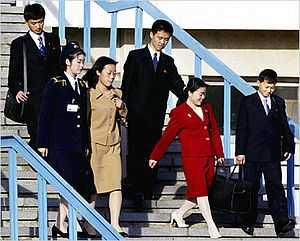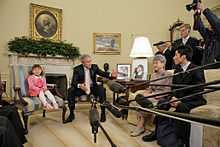North Korean abductions of Japanese citizens

| Part of a series on |
| Human Rights in North Korea |
|---|
 |
|
Human rights abuses |
|
International reactions |
The abductions of Japanese citizens from Japan by agents of the North Korean government happened during a period of six years from 1977 to 1983.[1] Although only 17 Japanese (eight men and nine women) are officially recognized by the Japanese government as having been abducted,[2] there may have been hundreds of victims.[3] The North Korean government has officially admitted to abducting 13 Japanese citizens.[4]
There are testimonies that many non-Japanese citizens, including nine European citizens,[5] have been abducted by North Korea.[6]
Some districts in Japan fund North Korean-run schools, which teach children that the abduction issue was fabricated by Japan.[7]
Background
Most of the missing were in their 20s; the youngest, Megumi Yokota, was 13[8] when she disappeared in November 1977, from the Japanese west coast city of Niigata. The North Korean government claims that she committed suicide in March 1994.[9]
It is believed that the victims were abducted to teach Japanese language and culture at North Korean spy schools.[8] Older victims were also abducted for the purpose of obtaining their identities, but these abductees are believed to have been killed immediately. It is speculated that Japanese women were abducted to have them become wives to a group of North Korea-based Japanese terrorists after a 1970 Japan Airlines hijacking and that some may have been abducted because they happened to witness activities of North Korean agents in Japan, which may explain Yokota's abduction at such a young age.[10]
For a long time, these abductions were denied by North Korea and its sympathizers (including Chongryon and the Japan Socialist Party) and were often considered a conspiracy theory. Despite pressure from Japanese parent groups, the Japanese government took no action.
There are claims that this issue is now being used by Japanese nationalists, including Prime Minister Shinzō Abe, to "further militarize", push for revision of the Constitution to reduce constitutional limits on the army, revise the Basic Education Law and forward other political goals.[11][12] Such claims have been criticized by Kyoko Nakayama, the special adviser in Tokyo to the Japanese prime minister on the abduction issue, who said "This is about rescuing our citizens (from ongoing abduction). They deserve all possible support to regain their freedom and dignity. It is our duty to retrieve them." (See Norimitsu Onishi.)
Talks between North Korea and Japan in 2002 and aftermath
On September 17, 2002, Japanese Prime Minister Junichiro Koizumi visited North Korea to meet North Korean leader Kim Jong-il. To facilitate normalization of relations with Japan, Kim admitted North Korea had abducted 13 Japanese citizens and issued an oral apology. He attributed the abductions to "some people who wanted to show their heroism and adventurism," and avoided taking the blame.
North Korea also provided death certificates for eight people who the North claimed were dead, but later admitted that they were forgeries in a conference in November, 2004.
Return of five victims
Later, North Korea allowed the five victims that it said were alive to return to Japan, on the condition that they return later to North Korea. The victims returned to Japan on October 15, 2002.
However, the Japanese government, listening to the pleas of the general public and the abductees' families, told North Korea that the victims would not be returning. North Korea claimed that this was a violation of the agreement and refused to continue further talks.
The five repatriated victims were Yasushi Chimura and his wife Fukie, Kaoru Hasuike and his wife Yukiko, and Hitomi Soga - the wife of Charles Robert Jenkins, who remained in North Korea.
Children/spouses of returned victims reunited
The three children of the Chimura family and the two children of the Hasuike family, who were born in North Korea, were allowed to rejoin their parents in Japan following the second visit of Japanese Prime Minister Koizumi to Pyongyang on May 22, 2004. All five children expressed willingness to remain in Japan and live as Japanese, per their parents' and other relatives' accounts.
Hitomi Soga was able to reunite with her husband and children, but through a more circuitous route. Her husband, Charles Robert Jenkins, was a defector from the United States Army who fled to North Korea where he eventually met and married Soga. Fearing a court-martial, Mr. Jenkins and their two daughters initially met Soga in Jakarta, Indonesia, on July 9, 2004, eventually returning together to Japan on July 18. Two months later, on September 11, 2004, Jenkins reported to the army base at Camp Zama, Japan, served a light sentence after being found guilty of desertion and aiding the enemy, and was discharged dishonorably from the army. The family currently lives on Sado Island in Japan.
Further evidence and investigations
In November 2004, North Korea returned the cremated remains of two people, stating that they were those of Megumi Yokota and Kaoru Matsuki, who the North claimed died after being abducted. Subsequent Japanese DNA testing determined that those remains belonged to neither of the two. However, the independent scientific journal Nature published an article highly critical of this testing, which was performed at Teikyo University by Tomio Yoshii, a relatively junior faculty member (lecturer) in a forensics department, without a professor being present. Yoshii later acknowledged that he had no previous experience in the analysis of cremated specimens. This mistake — intentional or not — further strained relations between Japan and North Korea and is discussed in more detail in the article on Megumi Yokota.
In an interview with Japanese police, Yasushi Chimura and Kaoru Hasuike, two of the abductees allowed to return to Japan in 2002, identified two of their abductors as Sin Gwang-su (known also as Sin Kwang-su) and a man known as "Pak". The National Police Agency has requested the arrests of Sin Gwang-su and Choi Sung Chol for the abductions of Japanese nationals. Sin reportedly told police in South Korea that he had been personally ordered by Kim Jong-il to carry out abductions.[13]
In March 2006, Osaka police raided six facilities, including the North Korean Chamber of Commerce, in an investigation into the circumstances surrounding the June 1980 disappearance of one of the alleged abductees, Tadaaki Hara. All six facilities were linked to Chongryon, a pro-Pyongyang Korean residents' organization in Japan. A police spokesman said that the head of Chongryon at the time was suspected of cooperating in his abduction.[14]
Current situation


The North Korean government continues to claim that there were only 13 abductees and that the issue has been resolved with the return of the five victims. However, the Japanese government claims that the issue has not been properly resolved, and that all evidence provided by the North is forged.
By May 2004, five abductee victims and their families (10 in total) returned from North Korea. However, a number of alleged victims are still missing.
Although then Chief Cabinet Secretary Hiroyuki Hosoda commented on December 24, 2004, that "unless honest measures are taken swiftly, we cannot help but impose strict measures," hinting at possible sanctions, such moves have not yet been taken by the Japanese government.[15]
The victims' support group has also looked to the United Nations for help. United Nations Secretary General Kofi Annan, in a speech given in the Japanese Diet on February 24, 2004, mentioned the issue, sympathized with the victims and their families, and expressed wishes for a complete settlement.[16]
Later that year, the United States Congress passed the North Korean Human Rights Act of 2004.[17] In response to this, the South Korean ruling party, not wanting to damage North-South relations, expressed concern. On the other hand, the victims' families and their supporters expressed gratitude toward the United States government and president.[18]
In 2004, the Japanese Diet passed two laws designed to restrict trade with North Korea.[19]
On November 2, 2005, the United Kingdom led 45 countries, including the United States and Japan, in submitting a proposal condemning North Korea to the United Nations. On December 16, this proposal was passed by the General Assembly with 88 supporting, 21 opposing and 60 abstention votes. In particular, China and Russia opposed this proposal and the South Korean government abstained. The proposal condemned North Korea for "systematic humanitarian violations" and mentioned the abduction issue, the existence of concentration camps and the abuse against North Korean defectors sent back to North Korea.[20]
A working group dealing with human rights abuses has also been set up at the six-party talks.
United States Secretary of State Condoleezza Rice expressed support for the abduction issue.[21]
On April 27, 2006, Sakie Yokota, mother of abductee Megumi Yokota, testified in a United States House of Representatives subcommittee about the abduction issue. The next day, Yokota met with US President George W. Bush to ask for the United States' help in resolving the abduction issue. The President called the meeting "one of the most moving meetings" in his presidency and questioned North Korea's actions.[22]
On June 13, 2006, the North Korean Human Rights Bill, calling for sanctions to be placed on North Korea, was tabled in the Japanese Diet.[23]
Following Kim Jong-il's death in December 2011, former abductee Kaoru Hasuike expressed a wish for the Japanese government to "carefully analyze the state of affairs in North Korea and do its best to secure the safety of abductees still left there".[24]
The abduction issue has become very central to Japan's North Korea policy and Japan's participation in the Six-Party Talks. Most importantly, "Tokyo has kept conditioning its provision of economic incentives, widely deemed to be crucial to a comprehensive and lasting solution of the nuclear conundrum, on the establishment of diplomatic relations with North Korea—a development which in turn hinges on a resolution of the abduction issue."[25]
On August 29, 2013, families of victims including the Yokotas testified on a UN team hearing [26][27][28]
In May 2014 after talks with Japan, North Korea agreed to probe the abductees issue.[29]
On 4 July 2014, Japan eased several of its sanctions on North Korea after talks between the two countries. Pyongyang agreed to reopen investigations about the abduction cases.[30]
In October 2014 Japanese delegation visited North Korea[31] [32][33][34][35][36][37][38][39]
In March 2015, after talks with North Korea failed to produce results, Japan extended its sanctions for two more years. These include barring North Korean ships from entering Japanese ports and limits on trade with the country.[40]
Victims officially recognized by the Japanese government
Seventeen nationals are officially recognized by the Japanese government as victims of the abduction issue.[9] The sixteenth, Minoru Tanaka, was added to the list on April 27, 2005, following discovery of evidence supporting the assertion that he was abducted.[41] The seventeenth victim, Kyoko Matsumoto, was added to the list in November 2006.[9]
| Name | Sex | Born | Circumstances of disappearance | Current status |
|---|---|---|---|---|
| Yutaka Kume | Male | ca. 1925 | Disappeared September 19, 1977 from Noto Peninsula, Ishikawa Prefecture | North Korea denies any involvement[9] |
| Megumi Yokota | Female | October 15, 1964 | Disappeared November 15, 1977 from Niigata, Niigata Prefecture | Allegedly died March 13, 1994 in North Korea [date was originally announced as 1993 but was later corrected by Pyongyang] |
| Minoru Tanaka | Male | ca. 1950 | Disappeared June 1978. Persuaded to go overseas, and taken to North Korea later.[41] | North Korea denies any involvement[42] |
| Yaeko Taguchi | Female | August 10, 1955 | Disappeared June 1978 from an undetermined place.[9] | Allegedly died July 30, 1986 in North Korea. However, Kim Hyon Hui, the surviving bomber of Korean Air flight 858, denied North Korea's claim.[43] |
| Yasushi Chimura | Male | June 4, 1955 | Disappeared July 7, 1978 together with his fiancee Fukie Hamamoto near coast of Obama, Fukui. | Alive (returned) |
| Fukie Hamamoto | Female | June 8, 1955 | Disappeared July 7, 1978 together with her fiance Yasushi Chimura near coast of Obama, Fukui. | Alive (returned) |
| Kaoru Hasuike | Male | September 29, 1957 | Disappeared July 31, 1978 with his girlfriend Yukiko Okudo from coast of Kashiwazaki, Niigata. | Alive (returned) |
| Yukiko Okudo | Female | April 15, 1956 | Disappeared July 31, 1978 with her boyfriend Kaoru Hasuike from coast of Kashiwazaki, Niigata. | Alive (returned) |
| Hitomi Soga | Female | May 17, 1959 | Disappeared together with her mother Miyoshi Soga August 12, 1978 from Sado Island, Niigata Prefecture | Married Charles Robert Jenkins, a deserter from the United States Army, in 1980, and returned to Japan with him in 2004. |
| Miyoshi Soga | Female | ca. 1932 | Disappeared together with her daughter Hitomi Soga August 12, 1978 from Sado Island, Niigata Prefecture | North Korea asserted that Miyoshi Soga never entered the country.[9] |
| Rumiko Matsumoto | Female | November 1, 1954 | Disappeared August 12, 1978 from Fukiage, Kagoshima Prefecture, together with her boyfriend Shuichi Ichikawa | Allegedly died August 17, 1981 in North Korea |
| Shuichi Ichikawa | Male | October 20, 1954 | Disappeared August 12, 1978 from Fukiage, Kagoshima Prefecture, together with his girlfriend Rumiko Matsumoto | Allegedly died September 4, 1979 in North Korea |
| Toru Ishioka | Male | June 29, 1957 | Disappeared May 1980 from Madrid, Spain during a trip in Europe | Allegedly died November 4, 1988 in North Korea |
| Kaoru Matsuki | Male | June 23, 1953 | Disappeared May 1980 from Madrid, Spain during a trip in Europe | Allegedly died August 23, 1996 in North Korea |
| Tadaaki Hara | Male | August 10, 1936 | Disappeared June 1980 from Miyazaki, Miyazaki Prefecture | Allegedly died July 19, 1986 in North Korea |
| Keiko Arimoto | Female | January 12, 1960 | Disappeared June 1983 from Copenhagen, Denmark[44] while studying English abroad | Allegedly died November 4, 1988 in North Korea. |
| Kyoko Matsumoto | Female | 1948 | Disappeared October 21, 1977 on her way to knitting class near her home | As of 2010, North Korea has given no response to Japanese demands.[9] |
Other abductions by North Korea
North Korea has also perpetrated abductions in South Korea, which has the highest number of citizens abducted by the North. The number of South Korean abductees is put at 485[45] or 486.[46]
In December 1969, a Korean Air Lines YS-11 was hijacked by a North Korean agent soon after taking off from Gangneung.[47] The pilot was forced to fly to and land in North Korea. The crew, aircraft, and seven of the passengers have yet to be returned. North Korea claims that this was an act of asylum by the pilot, but it is considered to be another case of abduction.
In the 1970s, many women were abducted from Lebanon and in July 1977 there was an attempt to abduct a Korean pianist/actress and her spouse from Yugoslavia.[47] There were also incidents in which South Korean high school students were abducted.
There are testimonies that several others have been abducted, including two Chinese (Macau), two Dutch, three French, three Italians, a Jordanian, four Malaysians and a Singaporean.[6] There is also some evidence that suggests that a missing American citizen, David Sneddon, was kidnapped while traveling in China in 2004 by North Korean agents and brought to somewhere just outside of Pyongyang to teach English.[48]
The United Nations Commission on Human Rights has begun investigations on the Korean abductees. Abductee Hitomi Soga has also testified that citizens of Romania and Thailand were among the abductees.[49] The family of an abduction victim from Thailand has been identified and the Japanese government is working with the Thai government to resolve the issue.
According to the Committee for Democratisation of North Korea (CDNK), North Korean agents are also believed to have abducted roughly 200 citizens of the People's Republic of China from the late 1990s onwards, mostly ethnic Koreans from frontier towns in northeast China who provided aid to North Korean defectors. The kidnap victims were then imprisoned in North Korea. The Chinese government reportedly has not officially requested the repatriation of any of these victims, a policy the CDNK describes as aimed at preserving harmony in the countries' bilateral relations.[50]
The disappearance of American student David Sneddon in Yunnan, China in 2004 is also claimed by his parents to be due to a Korean abduction.[51]
Controversies
There is also controversy about whether the remains of Megumi Yokota returned by North Korea to Japan are hers or not. The Japanese government tested them and claims they are not. But in February 2005, the British scientific journal Nature published an article in which Teikyo University DNA analyst who did the tests, Tomio Yoshii, acknowledged that the results could be inconclusive. Likewise, the technique used is reportedly no longer used professionally in the United States due to the ease with which contamination can occur. According to the Japanese Foreign Ministry, the remains are not available for further testing.[52]
Another controversy arose when in May 2012, Japan strongly protested when a top American diplomat linked the issue of North Korean abductions of Japanese citizens with the issue of abduction to Japan by Japanese parents away from non-Japanese parents. [53]
In fiction
The protagonist of the novel The Orphan Master's Son spends several years during the early part of the book helping with and organising abductions of Japanese to North Korea. These abductions and some of their victims remain an important secondary theme for the rest of the book.
See also
- North Korean abductions of South Koreans
- Megumi Yokota
- Abduction: The Megumi Yokota Story
- Japanese people in North Korea
- Kim Hyon Hui
- Korean War POWs detained in North Korea
- Human rights in North Korea
References
- ↑ Japanese Government Internet TV
- ↑ Japanese Government Headquarters for the Abduction Issue
- ↑ Investigation Commission on Missing Japanese Probably Related to North Korea(COMJAN)
- ↑ "North Korea rejects DNA link to Megumi Yokota abduction case". Associated Press. Retrieved 2006-05-01.
- ↑ Le Figaro article on French abductees
- ↑ 6.0 6.1 National Association for the Rescue of Japanese Kidnapped by North Korea
- ↑ (Japanese) Government of Tokyo
- ↑ 8.0 8.1 McCurry, Justin (October 16, 2002). "North Korea's kidnap victims return home after 25 years". The Guardian (London). Retrieved 2006-05-01.
- ↑ 9.0 9.1 9.2 9.3 9.4 9.5 9.6 Ministry of Foreign Affairs (Japan). "Abduction of Japanese Citizens by North Korea" (PDF). Retrieved 2010-07-23.
- ↑ http://www.slate.com/id/2087627/ Why North Koreans Were Kidnappers
- ↑ Norimitsu Onishi (December 17, 2006). "Abduction issue used by Japanese nationalists". International Herald Tribune. Retrieved July 26, 2010.
- ↑ Gregory Clark (Japan Times). "Ideological laundry unfurled". Retrieved 2006-11-21.
- ↑ "The Japan News - Breaking News from Japan by The Yomiuri Shimbun". Yomiuri.co.jp. Retrieved 2014-02-05.
- ↑ "Transcript of the Japan Considered Podcast Volume 02, Number 14 - Relations with North Korea". Japan Considered Podcast. April 7, 2006. Retrieved 22 July 2010.
- ↑ National Association for the Rescue of Japanese Kidnapped by North Korea. "Prospectus". Retrieved 2006-05-01.
- ↑ アナン国連事務総長の訪日 (Japanese), The Ministry of Foreign Affairs of Japan
- ↑ http://www.theorator.com/bills108/hr4011.html North Korean Human Rights Act of 2004
- ↑ the National Association for the Rescue of Japanese Kidnapped by North Korea
- ↑ http://search.japantimes.co.jp/cgi-bin/nn20040407a2.html "Bill to bar ships from ports goes to Diet"
- ↑ 北朝鮮人権非難決議、国連総会で初採択...拉致など指摘, Yomiuri Shinbun, 2005.12.17.
- ↑ Ministry of Foreign Affairs (Japan). "Visit to Japan by U.S. Secretary of State Rice". Retrieved 2006-05-01.
- ↑ Iwama, Toshimitsu. "Bush meets family of Japanese woman abducted by North Korea". Retrieved 2006-04-30.
- ↑ BBC News Online (June 13, 2006). "N Korea to face Japan sanctions". London. Retrieved 2006-06-13.
- ↑ "Japan eyes new North Korea with caution". Retrieved 2012-02-10.
- ↑ Hagström, Linus (2009) “Normalizing Japan: Supporter, Nuisance, or Wielder of Power in the North Korean Nuclear Talks,” Asian Survey 49 (5): 848, http://caliber.ucpress.net/doi/abs/10.1525/as.2009.49.5.831?journalCode=as
- ↑ Ryall, Julian (2013-08-29). "Parents of Japanese schoolgirl abducted by North Korea 'lived in fear every day'". London: Telegraph. Retrieved 2014-02-05.
- ↑ Lies, Elaine (August 29, 2013). "Japanese mother tells of heartbreak years after North Korea abducted 13-year-old daughter". Reuters. Retrieved 2014-02-05.
- ↑ "U.N. mission hears from kin of North Korea's abduction victims". The Japan Times. Retrieved 2014-02-05.
- ↑ http://www.bbc.co.uk/news/world-asia-27620549
- ↑ Japan eases sanctions on North Korea after talks on abductions
- ↑ http://www.reuters.com/article/2014/10/30/us-japan-northkorea-idUSKBN0IJ1RA20141030
- ↑ http://www.nytimes.com/2014/04/12/opinion/signals-from-north-korea.html?_r=0
- ↑ http://www.bbc.co.uk/news/world-asia-26607446
- ↑ http://ajw.asahi.com/article/behind_news/politics/AJ201410050024
- ↑ http://edition.cnn.com/2014/03/17/world/asia/japan-north-korea-abductee-meeting/
- ↑ http://www.telegraph.co.uk/news/worldnews/asia/northkorea/10702048/Elderly-Japanese-couple-meet-family-of-daughter-kidnapped-by-N-Korea.html
- ↑ http://ajw.asahi.com/article/asia/korean_peninsula/AJ201403170078
- ↑ http://www.reuters.com/article/2014/07/01/us-japan-northkorea-daughter-idUSKBN0F638G20140701
- ↑ http://www.nytimes.com/2014/03/17/world/asia/parents-of-japanese-woman-kidnapped-by-north-korea-meet-their-granddaughter.html
- ↑ Takahashi, Maiko (March 31, 2015). "Japan to Extend Sanctions on North Korea Over Abductee Issue". Bloomberg. Retrieved Mar 31, 2015.
- ↑ 41.0 41.1 Ministry of Foreign Affairs of Japan (MOFA) (July 2007). 外務省: 北朝鮮による日本人拉致問題 (in Japanese). Archived from the original on April 21, 2008. Retrieved July 25, 2010.
- ↑ 神戸新聞ニュース:総合/2005.04.26/北朝鮮の拉致断定 神戸出身の田中実さん
- ↑ "Japanese Abduction Victim Still Alive, Says KAL Bomber". The Chosun Ilbo (English Edition). January 16, 2009. Retrieved July 25, 2010.
- ↑ Suspected Abduction Case of a Japanese Female in Europe National Police Agency
- ↑ Nakamura, Yuichiro. "S. Korea reacts to abductions". Retrieved 2006-04-30.
- ↑ Lankov, Andrei. "Body snatching, North Korean style". Retrieved 2006-04-30.
- ↑ 47.0 47.1 Nanto, Dick K. "North Korea: Chronology of Provocations, 1950 - 2003" (PDF). Retrieved July 25, 2010.
- ↑ Vogel, Chris. "Did North Korea Kidnap an American Hiker?" (HTML). Retrieved Dec 12, 2014.
- ↑ Takahara, Kanako. "Abductees' multinational kin unite". Retrieved 2006-04-30.
- ↑ "N.Korea kidnapped Chinese in refugee crackdown: report". Agence France-Presse. 2009-11-17. Retrieved 2009-11-18.
- ↑ American Family Believes Missing Son Held in N. Korea
- ↑ Donald Macintyre (March 28, 2005). "Bones of Contention". Time Magazine. Retrieved 2010-07-27.
- ↑ Campbell's Hague Plea Irks North Abductee Kin, Japan Times 9 May 2012
External links
- Headquarters for the Abduction Issue, Government of Japan, requesting information to resolve the issue
- The abductions of Japanese citizens by North Korea, Prime Minister of Japan and his Cabinet — Symbolic
- North Korean Abduction Victims Worldwide, National Association for the Rescue of Japanese Kidnapped by North Korea
- Investigation Commission on Missing Japanese Probably Related to North Korea
- MEGUMI(Japanese animation) - English, animation short film about the abductee Megumi Yokota.
- Noel Paul Stookey: Song for Megumi
- THINK (Their Home Isn't North Korea)
- Abduction - The Megumi Yokota Story (film about the most famous abduction case)
- President George W. Bush meets with North Korean Defectors and Family Members of Japanese Abducted by North Korea Office of the Press Secretary, April 28, 2006, White House